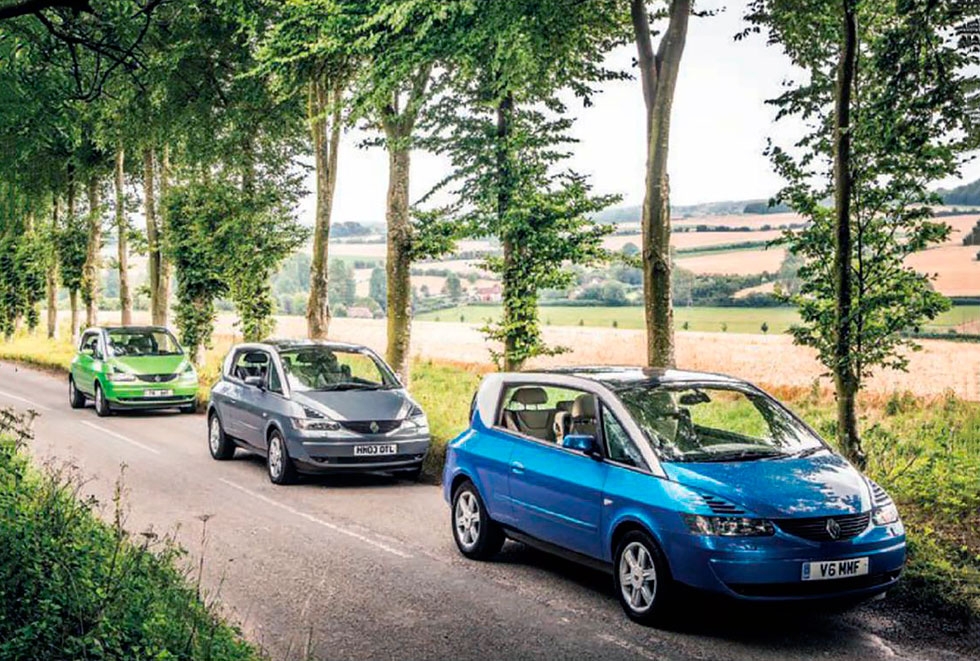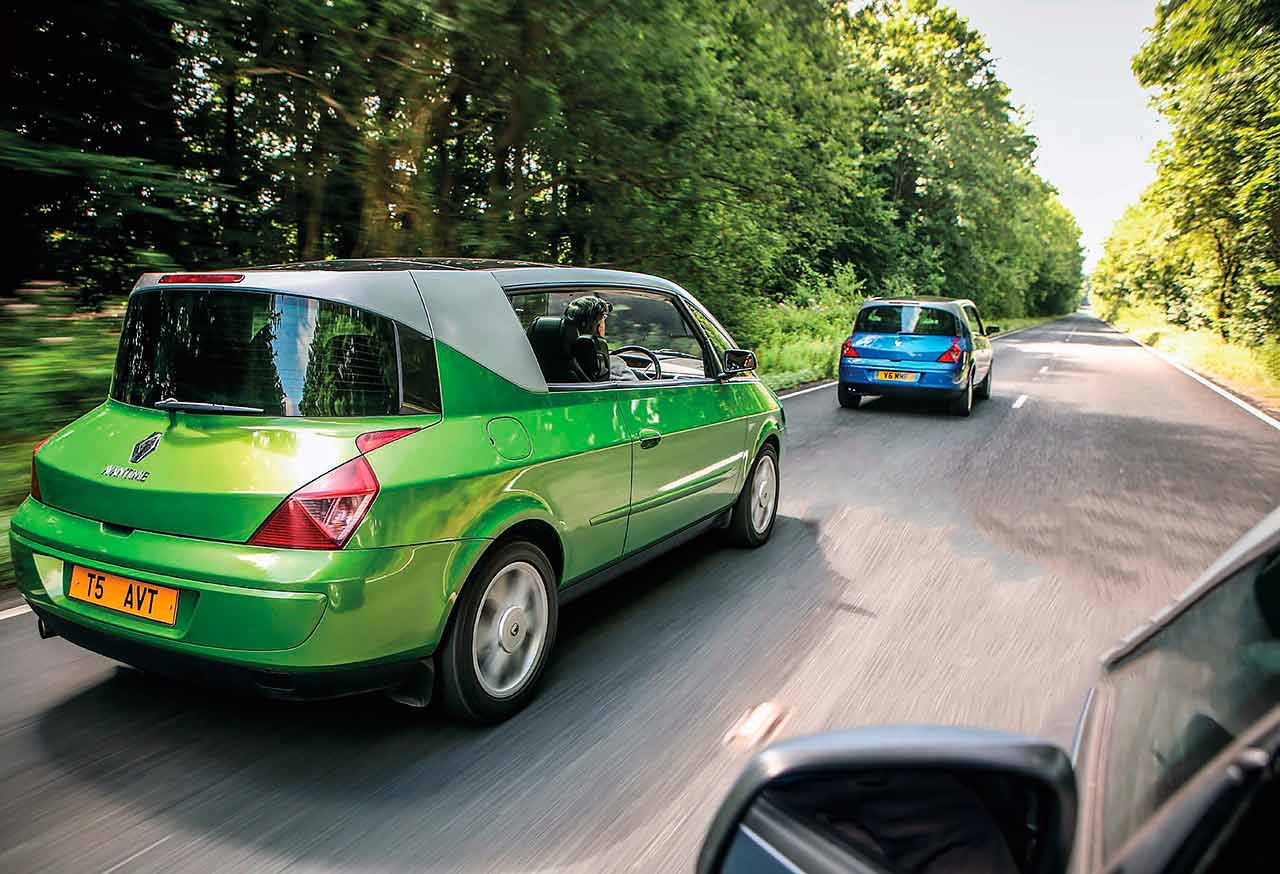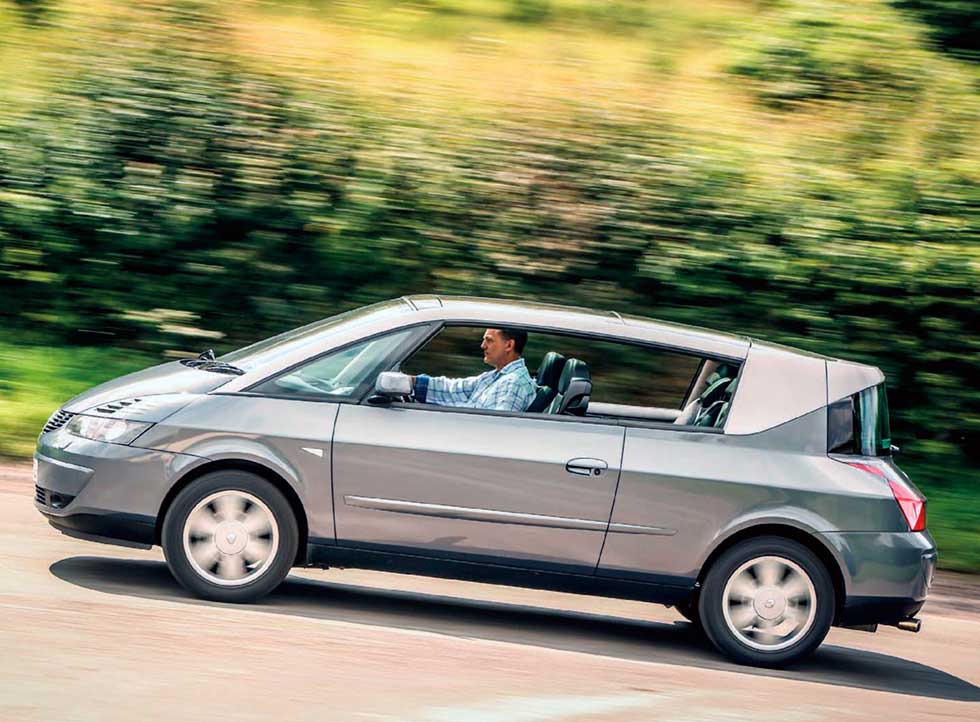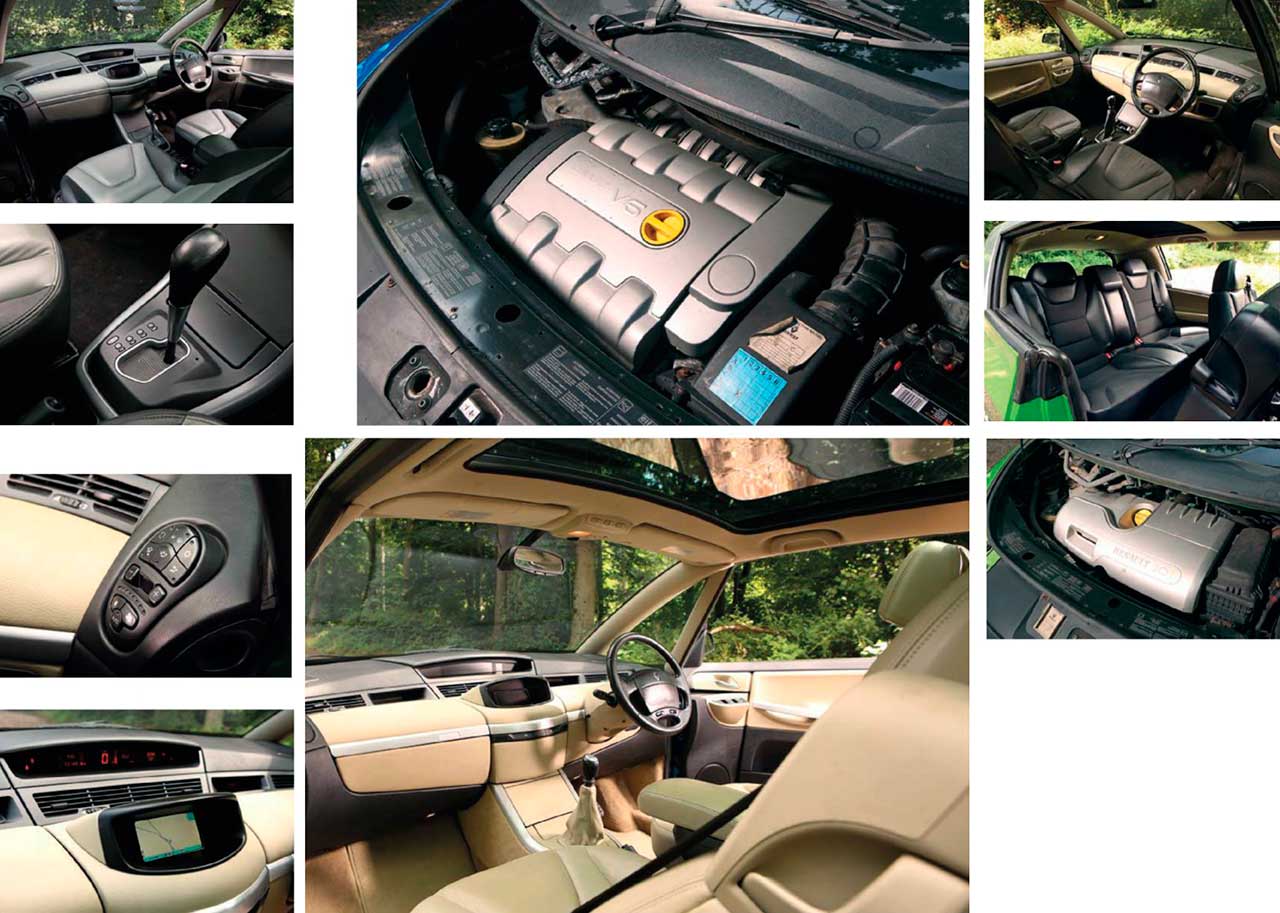
Avant-garde Avantime Renault’s radical MPV. Revolutionary Renault. The showstopping Avantime melded coupé and MPV in a unique package. Ahead of the curve. Renault’s brilliant Avantime forged a niche as an MPV coupé and is a sure-fire classic today. Martin Buckley celebrates this French revolutionary as he meets two of its most ardent fans. Photography Tony Baker.
The Renault Avantime, to its rapidly growing band of sympathisers, is the perfect answer to that old dilemma of how to combine hard-to-define classic charm with modern-car practicality. The Avantime has both qualities in abundance, and you can sell it to yourself wearing any hat you like – certainly as a funky but thoroughly usable modern classic (the last examples were built 14 years ago). I don’t think there’s anything to touch these things, irrespective of price, and I’m betting that values have a long way to go in a market where you can still buy good ones for five grand and the best examples for £20,000. Really nice cars are already making more than that in Europe.

What is an Avantime? In essence, it is a capacious, crash-worthy luxury four-seater coupé from the turn of the millennium, stuffed to the brim with Renault family values. It is not a sports car, yet it rides, handles and performs in a recognisably early-21st-century way. But it is so much more than that. This is a Renault that recaptured some of the design ambition and leadership that the firm had shown decades earlier in cars such as the R16 and original R5. As the world’s first MPV coupé, the 2001 Avantime was a mould-breaker that offered buyers something they didn’t know they needed: a luxurious two-door with a feeling of lounge-like spaciousness thanks to an ingenious glass top and pillarless side glazing.
Here was the gran turismo people carrier; a ‘lifestyle’ super-Espace created for well-heeled, design-conscious empty nesters who no longer needed the absolute rationality of a single-box people-mover, but who had grown to love the elevated views and seating positions of the hugely successful front-drive seven-seater upon which the Avantime was based.
All of this was wrapped up in an elegantly futuristic body that’s proved curiously immune to the ageing process. The prototype caused a sensation at the Paris Salon in 1998, and the production version still looks like a concept car – or at least an escapee from a styling clinic – in 2017. Scarcity (just 8557 were built) and a fleeting 18-month career only add to its curious mystique.
Responsibility for the commercial failure of the Avantime can be laid at several doors. The sheer expense of making them is by no means the least significant, and nor is the fact that it was undermined by the appearance of the totally in-house Vel Satis, onto which much of the marketing effort was then diverted.
The car’s creator, Renault design chief Patrick Le Quément, remains proud of the Avantime to this day and no doubt pleased that so many of his peers admired the brave stance it took. It was, in a way, a pioneer pointing towards today’s BMW X6 and the like, but created a good decade before public taste had acclimatised to such things.
“It was a very modern piece of design, but not much liked by many people,” Le Quément told Car in 2009, just before he retired. “It was two years too late to market and launched at the wrong time… and not designed to be built in hundreds per day. If we had done a more conservative design would it have sold better?
We will never know.” The development cost was 1.4bn francs or €280 million in today’s money. The Avantime was really a Matra production, commissioned by Renault using a modified Espace galvanised-steel base unit with alloy above the waistline (hence the two-tone effect) and unstressed composite panels below it. With its history of mid-engined glassfibre sports cars, missile manufacture and, of course, the first three generations of Espace, this colourful and adaptable engineering group was a natural candidate for building an oddity such as the Avantime. Matra could not have known that it would hasten the demise of its automobile activities, but when Renault decided that the fourth incarnation of Espace would be an entirely in-house project, the Avantime’s death warrant had been signed.

In late February 2003, with sales running at an embarrassing 15 cars a day, Matra ordered an immediate end to Avantime production at its Romarantin plant. Renault, meanwhile, got busy disassociating itself from the vehicle, pulling advertising and dealer-demonstration models across Europe in a damage-limitation exercise. Personally, I liked them from the beginning.
I drove my first at Renault’s proving ground at Val Bonne in 2001, and thought that everything about the thing was super-cool. The huge, frameless doors with a massive double-acting kinematic hinge meant that you didn’t have to swing them out fully in tight spaces to get in; useful in car parks. Then there was the elevated so-called ‘theatre seating’ for the rear passengers and that fabulous full-length glass roof – the largest in production at the time – with the Grand Air function that simultaneously opened all the windows and the roof at the same time.
Problems in engineering the complex mechanism and sorting the multiplex wiring loom had delayed manufacturing by a year. This seemed to get the showroom Avantime (which was surprisingly faithful to the concept car) off on the wrong foot with the buying public, most of whom viewed it with suspicion in any case.
Refreshing as it was, in a world of grey, boring and mostly German three-box luxury saloons, this was always going to be a hard sell – particularly because Renault seemed to drag its heels in getting diesel, 2-litre petrol turbo and even automatic versions into showrooms. At first it was Hobson’s choice of the 3-litre V6 manual.
La Régie’s British operation – which had predicted sales of 1500 right-hookers a year – got the picture fairly quickly. Some 247 of the 452 UK-market cars had ‘Limited Edition’ plaques on their centre consoles (and were sold with a special certificate and presentation book), elegantly blurring the line between ‘failure’ and ‘exclusivity’.
Of those 452 Avantimes, about half were manual 2-litre turbos, badged Dynamique. The UK didn’t get the diesel versions or non-sunroof cars. The 3-litre V6s were sold as £30,000 Privilege models, mostly with a five-speed automatic gearbox plus full Bridge of Weir leather trim, sat-nav, six-CD changer and folding mirrors.
Only about 50 manual V6s were imported into the UK. Even rarer (particularly in right-hand drive) is the jazzy Exception Pack, with blue, red or grey interior trim rather than the usual cream. Jason Yorke-Edgell’s 27,000-mile Steel Grey V6 is just such a model. He also owns the 50,000- mile Iliad Blue Privilege V6 (a one-keeper example) pictured here and, while he hesitates to admit it, he is really one of the UK’s leading Avantime enthusiasts/collectors with at least half a dozen other examples to his name.
Mark Lumsden of Barnes restricts himself to four-cylinder turbo variants, of which he owns two: his Java Green car is still going strong after 126,000 miles, and is used every day. It neither burns oil nor uses water, so these are not the fragile machines that their reputation suggests. With about half of the Avantimes imported still on the road (and 50 known to have been scrapped) the rate of attrition could certainly be worse. Parts can be expensive – a heated windscreen for a 3-litre is £2000-plus – and, while mechanical items shared with the Espace are easy enough to find, model-specific bits are getting difficult. The Valeo-supplied rear light units, for instance, are no longer available from Renault.
On a more positive note, the cars don’t corrode (other than some superficial and easily rectified bubbling on the alloy roof rails) and even the infamous £1500 main-dealer V6 cambelt service – an engine-out job officially – can be performed by specialists for about half that. Yorke-Edgell can’t speak highly enough of Swift2 Motors in Worthing when it comes to getting quality work done, and points out that Renault was probably over-zealous in its maintenance recommendations in any case. He’s seen 15-year-old Avantime cambelts showing no visible deterioration.
Electrically, they can throw up the occasional warning light (like any car of the past 20 years) and I know from experience that automatic gearboxes can give problems. My first cheap-and-cheerful Avantime purchase lost drive completely in an M3 traffic jam, while the second one decided it liked going up through the gears but didn’t like changing down again, unless you stopped, switched off and allowed it to reset its electronics.
Undeniably, it is the 3-litre automatic that gives the driving experience that chimes in best with what Renault was trying to achieve. In other words, quiet, effortless, luxurious travel for four people in a car that feels as different from the inside as it looks from the outside. Bristling with airbags, the simple, elegant cabin is in many ways the glory of the car. This is not a gloomy German bunker, but rather a well-lit lounge.
There is even a secret compartment in the dash top and, underneath, a drawer that, if the catch is broken, will slide open under acceleration. The club now offers an easy fix for this, though. The materials are pleasing and, unlike most other high-spec vehicles of recent vintage, it doesn’t bombard you with controls and warning lights but rather soothes you with a central LED display and effective air-con with dual controls.
The V6 is silky and authoritative, its torque a perfect match for the automatic gearbox. You can leave that to its own devices or operate it manually in a sequential sport mode, which is intriguing for 10 minutes but not really what the Avantime is all about. Even the near-140mph manual – pleasant and flexible, with a light clutch – doesn’t exactly make the red mist descend.
The heavy front end on the V6s makes them run wide slightly when pushed and, although stability control, ABS and brake force distribution keep everything tidy, the 3-litre versions don’t inspire really ambitious driving. In the end, their front-drive chassis lacks finesse and they simply sit too tall, easily betrayed by the Espace underpinnings – even with suspension that was claimed to be 30% stiffer.
The 2-litre turbo is lighter on its feet, has better steering and in reality is hardly any slower. In fact, if you can live without the torque and majestic sound and smoothness of the sonorous 24-valve V6 unit, it may be the optimum choice. With 165bhp, it feels plenty lively enough – even in this 1625kg lump – and returns 30mpg compared to the low-20s of the 3-litre cars. Cruising in top, all versions are refined at the three-figure speeds that they will happily maintain all day. As you waft along in the outside lane – the edgy, cat-eyed form collecting multiple double-take stares from other motorists – you can appreciate how the Avantime is a sort of communal experience rather than a selfishly driver-focused one. It is about enjoying the process of the journey rather than simply getting there as quickly as possible.
Somehow you wouldn’t want to disturb your rear passengers with high-speed cornering antics when all they want is to lounge in those high-set leather armchairs, taking in the passing landscape through the big windows or finding a track on the CD with their own remote control.
Press the overhead Grand Air switch, and you cannot help being impressed by the way in which the side windows drop seamlessly into the body; the way one square metre of heat-resistant, anti-glare and shatterproof roof glass slides back in a single, perfectly choreographed action. From here, the Avantime takes on another sensory dimension and assumes the personality of a large four-seater cabriolet.
If, at that moment, you don’t at least concede just how brave and inventive this car was, then you will probably never ‘get’ this big Renault. These are cars that have always divided opinion and still do, leaving few unmoved. For every passionate Avantime advocate, there will be three or four for whom the whole idea of a luxury MPV coupé just does not compute – almost as if it were a form of automotive cross-dressing.
I have a friend who, having taken a ride in one of mine a few years ago, is convinced that the whole Avantime adventure was a sort of left-wing, cheese-eating conspiracy. It’s certainly true to say it is a car that could not be anything other than French. You probably won’t be surprised to learn that they are a popular choice of everyday transport for Citroën DS owners.
For Renault itself, the pain of the losses that the Avantime incurred are a fading memory and the model now seems to have been welcomed into the inner circle of classic models. Like so much of the more interesting stuff out there, it has proved to be a much better old car than it was a current model. As a goodwill ambassador for a make that is not exactly overwhelmed with a back catalogue of intriguing collectors’ items, I think it will look like a good long-term investment. Maybe that was the plan all along.
Thanks to Jason Yorke-Edgell, Mark Lumsden, www.avantime-owners.com
TECHNICAL DATA FILE SPECIFICATIONS Renault Avantime
Sold/no built 2001-2003/8557
Construction galvanised steel chassis, composite panels
Engine cast-iron block, alloy head, 16-valve turbocharged 1998cc dohc ‘four’/all-alloy dohc-per-bank 24-valve 2946cc 60° V6
Max power 165bhp @ 5000rpm or 210bhp @ 6000rpm / DIN
Max torque 184lb ft @ 2000rpm or 210lb ft @ 3750rpm / DIN
Transmission six-speed manual or five-speed automatic, driving front wheels
Suspension independent all round, at front by MacPherson struts, anti-roll bar rear trailing arms, coil springs
Steering power-assisted rack and pinion
Brakes discs all round, with servo and ABS
Length 15ft 2 ¼ in (4629mm)
Width 6ft (1829mm)
Height 5ft 3in (1600mm)
Wheelbase 8ft 8 ½ in (2654mm)
Weight 3583lb (1625kg)/3783lb (1716kg)
0-60mph 10.2 secs/8.7 secs
Top speed 127mph/137mph
Mpg 22-30
Price new £23,895-28,295
Price now £5-20,000


‘IT OFFERED BUYERS SOMETHING THEY DIDN’T KNOW THEY NEEDED: A LUXURIOUS TWO-DOOR ESPACE’
‘AS YOU WAFT ALONG, THE EDGY, CATEYED FORM COLLECTS DOUBLE-TAKE STARES FROM OTHER MOTORISTS’





